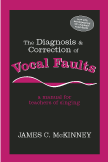“I really enjoyed this book. It was informative and detailed while remaining concise.” — Roberto Mancusi, Eastern New Mexico University
“A clear, well-structured approach to presenting basic concepts that every teacher and choral music educator needs to know.” — Gerald Seminatore, California State University, Fullerton

213 pages, $37.95 list
1-57766-403-5
978-1-57766-403-1
© 1994
paperback
eBook availability
The Diagnosis and Correction of Vocal Faults
A Manual for Teachers of Singing and for Choir Directors
Popular for more than two decades among college voice teachers and their students, this outstanding, authoritative vocal pedagogy text is an invaluable manual. It thoroughly examines the vocal problems prospective voice teachers will encounter daily in the teaching studio and choral rehearsal. The author’s approach is a unique one, based in large part on diagnostic procedures similar to those used by doctors. As each vocal fault is presented, its identifying characteristics or symptoms are stated, its possible causes are discussed, and corrective procedures are suggested. An especially valuable feature is the book’s accompanying audio files (available here for download) that contains 14 male and female voice samples of the various vocal faults discussed in the text, enabling students to better identify basic characteristic sounds associated with each fault.
Current and prospective choir directors and voice teachers who need help in improving the vocal sounds of choir members or students will find this practical guide-book to be an ever-present help in time of trouble.
Current and prospective choir directors and voice teachers who need help in improving the vocal sounds of choir members or students will find this practical guide-book to be an ever-present help in time of trouble.
Reactions
1. Diagnosing Vocal Faults
The Diagnostic Process / Identifying Vocal Problems / Diagnosis in the Teaching Studio / The Classification of Vocal Faults / A Plan of Action
2. A Basic Approach to Vocal Sound
The Nature of Sound / The Nature of Musical Instruments / The Nature of Vocal Sound
3. Posture
A Rationale for Good Posture / Arriving at Good Posture / A Description of Good Posture / Faults Related to Posture
4. Breathing and Support
The Breathing Mechanism / Breathing for Singing / Breath Support / Summary of Breathing Concepts / Faults Related to Breathing and Support / Four Incorrect Methods of Breathing / Other Breathing and Support Faults
5. Phonation
The Mechanism of the Larynx / Skeletal Framework of the Larynx / Musculature of the Larynx / The Phonatory Process / Characteristics of Good Vocal Sound / Faults Related to Phonation
6. Registration
What Is a Register / How Many Registers Are There? / The Vocal Fry Register / The Modal Voice Register / The Falsetto Register / The Whistle Register
7. Voice Classification
A Rationale for Voice Classification / Criteria for Establishing Voice Classification / A Quick Classification System for Choral Auditions / Dangers of Misclassification
8. Resonation
The Nature of Resonators / The Vocal Resonators / Adjusting the Resonators / Faults Related to Resonation
9. Articulation
The Articulatory Process / Establishing Good Articulatory Habits / Faults Related to Articulation
10. The Speaking Voice
Comparison of Speaking and Singing / Speech Level / Finding the Habitual Speech Level / Finding the Optimal Pitch Level / Common Speech Faults / Faults Related to Pitch / Faults Related to Quantity / Faults Related to Rate
11. Coordination
Introduction to Developing the Voice / Exercising the Voice / Extending the Range / Lining Up the Voice / Vibrato
Appendix 1: Audition Evaluation Checklist
Appendix 2: Phonetic Symbols Used in this Book
The Diagnostic Process / Identifying Vocal Problems / Diagnosis in the Teaching Studio / The Classification of Vocal Faults / A Plan of Action
2. A Basic Approach to Vocal Sound
The Nature of Sound / The Nature of Musical Instruments / The Nature of Vocal Sound
3. Posture
A Rationale for Good Posture / Arriving at Good Posture / A Description of Good Posture / Faults Related to Posture
4. Breathing and Support
The Breathing Mechanism / Breathing for Singing / Breath Support / Summary of Breathing Concepts / Faults Related to Breathing and Support / Four Incorrect Methods of Breathing / Other Breathing and Support Faults
5. Phonation
The Mechanism of the Larynx / Skeletal Framework of the Larynx / Musculature of the Larynx / The Phonatory Process / Characteristics of Good Vocal Sound / Faults Related to Phonation
6. Registration
What Is a Register / How Many Registers Are There? / The Vocal Fry Register / The Modal Voice Register / The Falsetto Register / The Whistle Register
7. Voice Classification
A Rationale for Voice Classification / Criteria for Establishing Voice Classification / A Quick Classification System for Choral Auditions / Dangers of Misclassification
8. Resonation
The Nature of Resonators / The Vocal Resonators / Adjusting the Resonators / Faults Related to Resonation
9. Articulation
The Articulatory Process / Establishing Good Articulatory Habits / Faults Related to Articulation
10. The Speaking Voice
Comparison of Speaking and Singing / Speech Level / Finding the Habitual Speech Level / Finding the Optimal Pitch Level / Common Speech Faults / Faults Related to Pitch / Faults Related to Quantity / Faults Related to Rate
11. Coordination
Introduction to Developing the Voice / Exercising the Voice / Extending the Range / Lining Up the Voice / Vibrato
Appendix 1: Audition Evaluation Checklist
Appendix 2: Phonetic Symbols Used in this Book